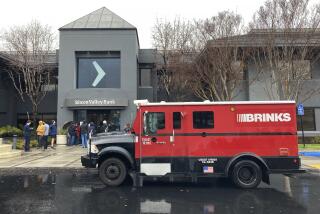Baldwin-United Assets Transferred; Annuity Holders to Get Payoffs
- Share via
The transfer of the remaining assets of bankrupt Baldwin-United to Metropolitan Life Insurance was completed Thursday, clearing the way for nearly 165,000 holders of Baldwin annuities--whose investments have been in limbo for four years--to get their money out or shift it into new Metropolitan Life policies.
“Basically, they’re going to be whole,” William G. Poortvliet, Metropolitan executive vice president, said of the Baldwin-United policyholders.
About $3.3 billion in assets from Cincinnati-based Baldwin-United’s insurance subsidiaries, which were headquartered in Indiana and Arkansas, were turned over to Metropolitan Life in New York by state insurance regulators, who had taken over the bankrupt companies. In addition, the securities and insurance industries contributed more than $200 million in order to honor the minimum interest commitment made in Baldwin-United’s contracts.
The industry contribution thus enhanced the payoff that would have been available under a court-devised plan using just Baldwin assets, Poortvliet said from Madrid, where Metropolitan coincidentally completed negotiations Thursday on a joint insurance venture with Banco de Santander.
Terms of Investment
At the time the Baldwin annuities were sold between 1979 and July, 1983--both by insurance agents and securities brokers--they paid 14% interest for the first year with a guaranteed minimum for the next 10 years, and what Poortvliet called “a rock-bottom guarantee” of 5.5% to 7.5% interest. Purchasers usually bought the annuities with a single payment--typically $20,000. The interest income remained untaxed until the investor began withdrawing benefits, generally at retirement.
“What happened (after the bankruptcy) was that not only were rates cut, but the policyholders couldn’t get access to their cash without penalties,” he said. “Since the beginning of 1984, they have been in limbo. This plan now will not only increase their rate but give them access to their benefits.”
Options to Be Explained
Most policyholders will receive more than their contracts’ minimum rates of interest, he said. The average is about 7.5%.
In New York, a Metropolitan spokesman said the company expects to make its first mailing to policyholders this month, explaining the options open to them. Basically, they will be able to exchange their Baldwin-United policies for Metropolitan Life policies that will pay interest enhanced by the industry contributions. The interest will be paid retroactively from May 1, 1984, to Nov. 1, 1987. At that time, policyholders will have the choice of accepting new policies at what Metropolitan termed “competitive interest rates,” without deductions for the normal sales commissions associated with new contracts.
About 100,000 policyholders nationwide had bought $2.1 billion in annuities from Baldwin-United’s Arkansas insurance operation from 1979 through July, 1983, when state regulators took them over. Another 65,000 bought another $1.3 billion in annuities over the same period from the company’s Indiana subsidiaries.
After Baldwin-United filed for bankruptcy, the National Assn. of Insurance Commissioners called on the insurance and securities industries to explore creation of an “enhancement plan” to improve upon the benefits that would otherwise be available once Baldwin-United’s assets were liquidated.
Twenty-two brokerage firms contributed $157 million to settle claims against them by their customers who bought Baldwin-United annuities. Fifty insurance companies later agreed to contribute an additional $50 million. The American Council of Life Insurers, a trade group, then called on Metropolitan to put an enhancement program together.
More to Read
Inside the business of entertainment
The Wide Shot brings you news, analysis and insights on everything from streaming wars to production — and what it all means for the future.
You may occasionally receive promotional content from the Los Angeles Times.









